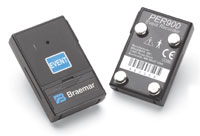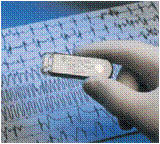Besides loop recorders, Holter monitors and 12 lead ECGs there are other cardiac diagnostic devices that a physician can use to evaluate patients suspected of having an arrhythmia.
Event Recorder: An event monitor or non-looping event recorder usually come in the shape of a credit card and unlike loop recorders, these units do not have to be attached through electrodes to the patient at all time. The patient can keep the recorder in his or her pocket, or wear the device around the neck, and can apply it to the chest when an episode occurs. Most patients may prefer this type of event monitor because of comfort and convenience. However an event recorder does not have loop memory since it is not attached to the patient all the time. The recording will only start after it is placed on the chest and activated. For some arrhythmias that are very short in duration, by the time the unit is applied on the chest, the arrhythmia may have been missed. Furthermore, this type of monitor is not useful for diagnosing syncope or fainting spells because, by the time a recording is made, the event that initially caused fainting may already have passed.
Once a recording is made successfully with patient activation, the data can then be downloaded through the telephone to a centralized station, where a technician analyzes the ECG tracings and sends to the physician. The physician can then correlate findings on the recording with patient’s symptoms. After 14 days of monitoring, patients would usually make an appointment with the physician to review the results.

________________________________________
Implantable Loop Recorder: When the above extensive testing are unable to identify an arrhythmia; yet, an arrhythmia is still suspected as the cause of patient’s symptoms, the physician may recommend to insert an implantable loop recorder. To help the physician explain patient’s symptoms, an implantable loop recorder records specific patient triggered events. However, the main difference is that this unit is implanted surgically on the chest so that it is there all the time. The patient can not simply forget to bring the unit with them at all times. Further, they wont feel uncomfortable in public since the unit can record automatically. The unit is there all day for 2 years and records the information continuously in a loop memory, and writes onto the hard memory when triggered by the patient or when an automatic detection algorithm is met. The automatic algorithm usually triggers a recording when the patient’s heartbeat is either too fast or too slow. These conditions usually cause symptoms of palpitations, lightheadedness, or fainting spells.
This very small (about 1×3 inches) device is implanted just under the skin on the chest, a surgery that usually takes about 5 minutes to complete and is done on an outpatient basis. The recorder uses its built-in electrodes on the unit to make recording of the heart rhythm. The internal battery can last 18 to 24 months. The advantages of this type of recorder are the patient will never “forget” to bring the recorder with him since it is already implanted under the skin and this recorder has the best chance of recording an arrhythmia that occurs very infrequently (i.e. once a year).


